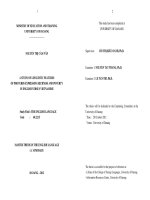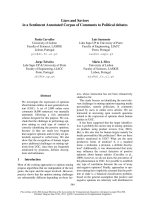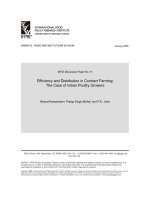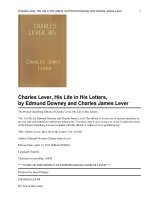Foreignization and domestication in trinh lus vietnamese translation of life of pi by yann martel
Bạn đang xem bản rút gọn của tài liệu. Xem và tải ngay bản đầy đủ của tài liệu tại đây (55.67 KB, 5 trang )
HANOI NATIONAL UNIVERSITY
UNIVERSITY OF LANGUAGES AND INTERNATIONAL STUDIES
FACULTY OF POST GRADUATE STUDIES
**********
NGUYỄN THỊ HƯƠNG
FOREIGNIZATION AND DOMESTICATION IN
TRINH LU’S VIETNAMESE TRANSLATION
OF “LIFE OF PI” BY YANN MARTEL
Ngoại hóa và Nội hóa trong bản dịch
“Cuộc đời của Pi” của Trịnh Lữ
M.A. MINOR Thesis
Field: English linguistics
CODE: 60 22 15
Hanoi, August, 2011
HANOI NATIONAL UNIVERSITY
UNIVERSITY OF LANGUAGES AND INTERNATIONAL STUDIES
FACULTY OF POST GRADUATE STUDIES
**********
NGUYỄN THỊ HƯƠNG
FOREIGNIZATION AND DOMESTICATION IN
TRINH LU’S VIETNAMESE TRANSLATION
OF “LIFE OF PI” BY YANN MARTEL
Ngoại hóa và Nội hóa trong bản dịch
“Cuộc đời của Pi” của Trịnh Lữ
M.A. MINOR Thesis
Field: English linguistics
CODE: 60 22 15
SUPERVISOR: Assoc. Prof. Trần Xuân Điệp, Ph.D.
Hanoi, August, 2011
TABLE OF CONTENTS
PART I: INTRODUCTION............................................................................................................ 1
1.
2.
3.
4.
5.
6.
7.
8.
STATEMENT OF THE PROBLEMS AND RATIONALE OF THE STUDY........................................... 1
OBJECTIVES OF THE STUDY....................................................................................................... 2
AIMS OF THE STUDY................................................................................................................... 2
SIGNIFICANCE OF THE STUDY.................................................................................................... 2
SCOPE OF THE STUDY................................................................................................................. 3
RESEARCH QUESTION................................................................................................................ 3
METHODOLOGY.......................................................................................................................... 3
DESIGN OF THE STUDY............................................................................................................... 4
PART II: DEVELOPMENT........................................................................................................... 5
CHAPTER 1: THEORETICAL BACKGROUND AND LITERATURE REVIEW........................................ 5
1.1. LANGUAGE, CULTURE AND TRANSLATION..................................................... 5
1.1.1. Concept of language................................................................................................... 5
1.1.2. Concept of culture....................................................................................................... 6
1.1.3. Concept of translation................................................................................................. 8
1.1.4. The relation between language and culture........................................................... 8
1.1.5. The relation between translation and culture........................................................ 9
1.2. TRANSLATION STRATEGIES................................................................................... 10
1.2.1. Linguistic Dichotomies............................................................................................ 11
1.2.2. Cultural Dichotomies............................................................................................... 14
1.3. TAXONOMY OF PROCEDURES RELATED TO FOREIGNIZATION AND
DOMESTICATION STRATEGIES...................................................................................... 17
CHAPTER 2: DATA ANALYSIS......................................................................................................... 22
2.1. Introduction......................................................................................................................... 22
2.2. Corpus.................................................................................................................................. 22
2.3. Design and Theoretical Framework.............................................................................. 22
2.4. Procedure............................................................................................................................. 23
2.5. Data Analysis...................................................................................................................... 23
2.5.1. Toponyms.................................................................................................................... 23
2.5.2. Anthronyms................................................................................................................ 24
2.5.3. Ecology........................................................................................................................ 25
2.5.4. Forms of entertainment............................................................................................ 26
2.5.5.Forms of art.................................................................................................................. 26
2.5.6. Local institution......................................................................................................... 26
2.5.7. Measuring system...................................................................................................... 27
2.5.8. Religious terminology.............................................................................................. 27
2.6. Findings and Discussion.................................................................................................. 27
2.6.1. Manifestations of Foreignization........................................................................... 29
2.6.2. Manifestations of Domestication........................................................................... 29
PART III: CONCLUSION............................................................................................................ 32
iii
3.1. RECAPITULATION OF MAIN IDEAS........................................................................................... 32
3.2. LIMITATIONS OF THE STUDY.................................................................................................... 33
3.3. SUGGESTIONS FOR FURTHER RESEARCH................................................................................. 33
iv
The present dissertation first focused on the theories concerning foreignisation and
domestication mechanisms. There followed a definition and classification of CSIs; the
chapter concluded with presentation of established classifications of translation
procedures.
A
consolidated
taxonomy
of
lexical
procedures
related
to
domestication/assimilation and foreignization/exoticism proposed by Kwieciński’s (2001)
is adopted as the theoretical framework. This is a product-oriented descriptive translation
research, this chapter of the study is devoted to describe and analyze cultural translation
strategies in the corpus by comparison ST and TT. An examination of the possible
translators’ procedures in the body of translated text reveals that Trịnh Lữ’s translations
of CSIs in the novel “Life of Pi” are essentially foreignising. The majority of CSIs are
borrowed into the Vietnamese version without any change. Borrowing procedure is
employed for translations of not only proper names but also other various categories such
as clothing items, forms of art, forms of entertainment, animals, etc. Foreignizing
strategies (borrowing, combinations and recognized exoticism) account for 85.7% while
normalisation and deletion which are representations of domestication make up for only
14.3 %. It is clear that procedures which are of foreignising nature constitute a majority
of applied procedures. This essentially demonstrates the dominance of foreignisation in
the transfer from culturally dominant SL to the inferior TL. Irrespective of the ideological
interpretation of its causes and effects, the overwhelming domination of E and the AngloAmerican culture remains a fact of life









